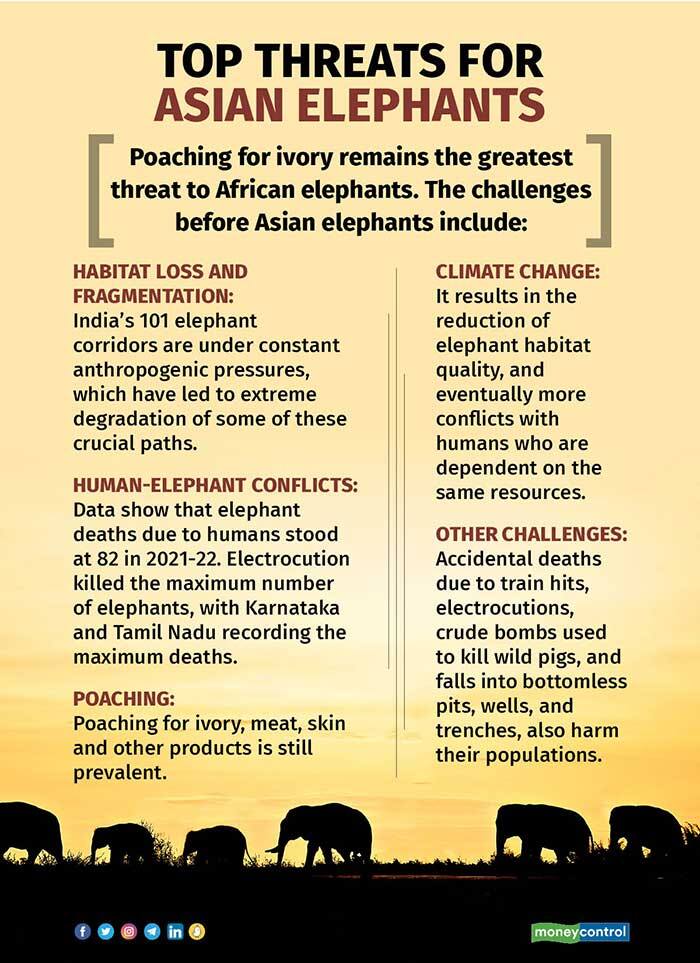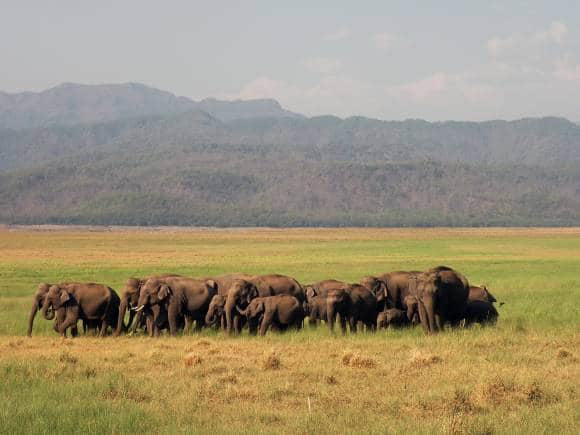



Photographer-filmmaker Kartiki Gonsalves was driving from Ooty to Bengaluru when she saw something that made her stop. It was a man and a baby elephant walking on the road. She pulled her car over and joined them. More than five years later, thanks to The Elephant Whisperers, the heart-warming story of Bomman, his wife Bellie and their ‘children’ Raghu and Ammu is famous the world over.
Also read: The Elephant Whisperers’ Kartiki Gonsalves: ‘When people start to understand elephants is when they start to love them’The Oscar-nominated documentary puts the relationship between humans and animals in the spotlight. It also drives home the larger message of protecting elephants and the need for conservation. For this keystone species, it could not have come at a better time.
Keystone species including wolves, elephants and otters, exerts a disproportionately large influence on their environment and are crucial to the conservation of their habitat.
Also read: Call of the wild: 10 keystone species that fight climate changeOnce common throughout Asia and Africa, elephant populations have seen significant declines over the past century. Currently, of the three species found on the planet, the African forest elephant is critically endangered as per the IUCN red list, while the African savannah elephant and Asian elephant are endangered.
Only 48,000-50,000 Asian elephants are found in wet forests and grassland habitats of 13 countries in Asia, and more than 60 percent of their wild population are in India alone. Once widely distributed throughout the country, here too their numbers have declined. Today, fragmented populations can be found in the south, north, central and northeast India.
Trunk callAsian elephants differ from their African relatives in several ways. For instance, Asian elephants are smaller in size. Only some male Asian elephants grow tusks, while both male and female African elephants have them. Females live in a matriarchal society, which is made up of related individuals. Males, on the other hand, either live alone or in small bachelor groups. They join female groups primarily for mating. After a gestation period that lasts 18 to 22 months, a single calf is born. Although the calf is naturally attached to its mother, other females in the group care for it too. This phenomenon is referred to as allomothering.

Elephants can live up to 60 to 70 years in the wild. They are purely vegetarian. An adult can eat 150-200 kg of fodder and drink up to 200 litres of water every day. So they need extensive land areas that are rich in food and water sources to survive and meet their ecological needs.
“As they roam their large home ranges, they play a critical role in protecting an ecosystem. Due to their large diet, they significantly impact trees and other vegetation, and also stomp out invasive species. Thus, they maintain large forest tracts’ diversity,” says Suman Jha, who works towards the conservation of elephants with the forest department of Tamil Nadu.
A study published in the journal Nature Geoscience adds that extinction of wild elephants would result in a 7 percent decline in carbon-storing vegetation.
 (Photo by A. J. T. Johnsingh, WWF-India and NCF)Top threats
(Photo by A. J. T. Johnsingh, WWF-India and NCF)Top threatsPoaching for ivory remains the greatest threat to African elephants. The challenges before Asian elephants are varied. They include:
Habitat loss and fragmentation: As their habitats become more fragmented, the pathways connecting them—corridors—have become increasingly important for them to roam freely. There are 101 elephant corridors in the country, but anthropogenic pressures have led to the extreme degradation of many, with the species facing the threat of being cut off.
Human-elephant conflicts: With habitats becoming fragmented and degraded, elephants are raiding plantations and crop fields in search for food or to move between forest patches. It brings them in direct conflict with people living in and around elephant habitats. Environment ministry data tabled in Parliament showed that elephant deaths due to humans stood at 82 in 2021-22. Electrocution killed the maximum number of elephants, with Karnataka and Tamil Nadu recording the maximum deaths.
Poaching: Poaching for ivory, meat, skin and other products is still prevalent. And since only males have tusks, it has resulted in a highly skewed male-female ratio in several areas.
Climate change: It results in the reduction of elephant habitat quality. An increase in extreme weather events such as droughts, heatwaves and floods can cause more conflicts with humans who are dependent on the same resources.
Other challenges: Accidental deaths due to train hits, electrocutions, crude bombs used to kill wild pigs, and falls into bottomless pits, wells, and trenches, also harm their populations.
The country has long been associated with captive elephants. “There are about 2,800 captive elephants in India. They have different protection guidelines as compared with wild elephants. Demand for them - either for entertainment purposes or for joyrides - also puts wild elephants at a huge risk. The government needs to address this loophole,” says Gajender K. Sharma, country director, World Animal Protection India.
India has strong cultural and religious links with these mega-herbivores. This makes elephants excellent flagship species in generating public support for conservation. Apart from Project Elephant, which is a centrally sponsored scheme for elephant conservation, organisations such as the Wildlife Trust of India, WWF India, Wildlife SOS, Asian Nature Conservation Foundation and Wildlife Conservation Society too are working towards the preservation of the species by securing their habitats, protecting corridors and minimising human-elephant conflicts.
The fate of these giants depends on it.
Oscars 2023 awards will be announced at 5.30 am IST on March 13.Discover the latest Business News, Sensex, and Nifty updates. Obtain Personal Finance insights, tax queries, and expert opinions on Moneycontrol or download the Moneycontrol App to stay updated!
Find the best of Al News in one place, specially curated for you every weekend.
Stay on top of the latest tech trends and biggest startup news.